Harris C.M., Piersol A.G. Harris Shock and vibration handbook
Подождите немного. Документ загружается.

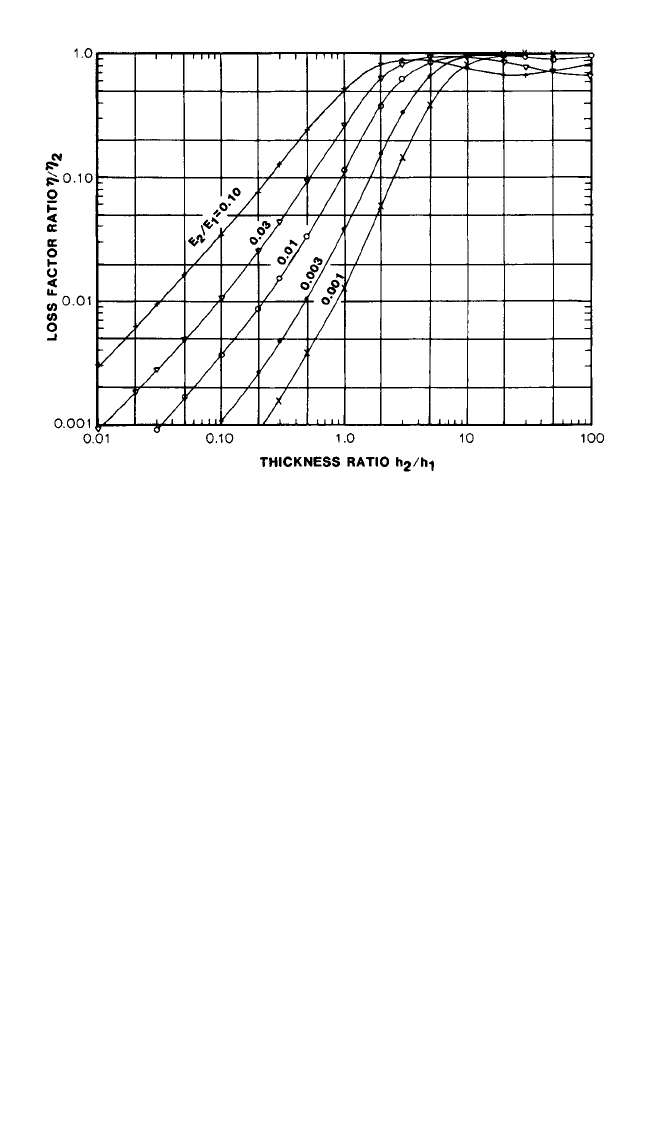
adequate, and continue the process until satisfied. Figure 37.3 illustrates how η/η
2
varies with E
2
/E
1
and with h
2
/h
1
, as calculated using the Oberst equations.
Limitations of Free-Layer Treatment Equations. The classical equations for
free-layer treatment behavior are approximate. The main limitation is that the equa-
tions are applicable to beams or plates of uniform thickness and uniform stiff
isotropic elastic characteristics with boundary conditions which do not dissipate or
store energy during vibration. These boundary conditions include the classical
pinned, free, and clamped conditions. Another limitation is that the deformation of
the damping material layer is purely extensional with no in-plane shear, which
would allow the “plane sections remain plane” criterion to be violated. This restric-
tion is not very important unless the damping layer is very thick and very soft (h
2
/h
1
> 10 and E
2
/E
1
< 0.001). A third limitation is that the treatment must be uniformly
applied to the full surface of the beam or plate, and especially that it be anchored
well at the boundaries so that plane sections remain plane in the boundary areas
where bending stresses can be very high and the effects of any cuts in the treatment
can be very important. Other forms of the equations can be derived for partial cov-
erage or for nonclassical boundary conditions.
Effect of Bonding Layer. Free-layer damping treatments are usually applied to
the substrate surface through a thin adhesive or surface treatment coating. This
adhesive layer should be very thin and stiff in comparison with the damping treat-
ment layer in order to minimize shear strains in the adhesive layer which would alter
the behavior of the damping treatment. The effect of a stiff thin adhesive layer is
minimal, but a thick softer layer alters the treatment behavior significantly.
Amount of Material Required. Local panel weight increases up to 30 percent
may often be needed to increase the damping of the structure in several modes of
APPLIED DAMPING TREATMENTS 37.7
FIGURE 37.3 Graphs of η/η
2
vs. h
2
/h
1
, for a free-layer treatment.
8434_Harris_37_b.qxd 09/20/2001 12:26 PM Page 37.7
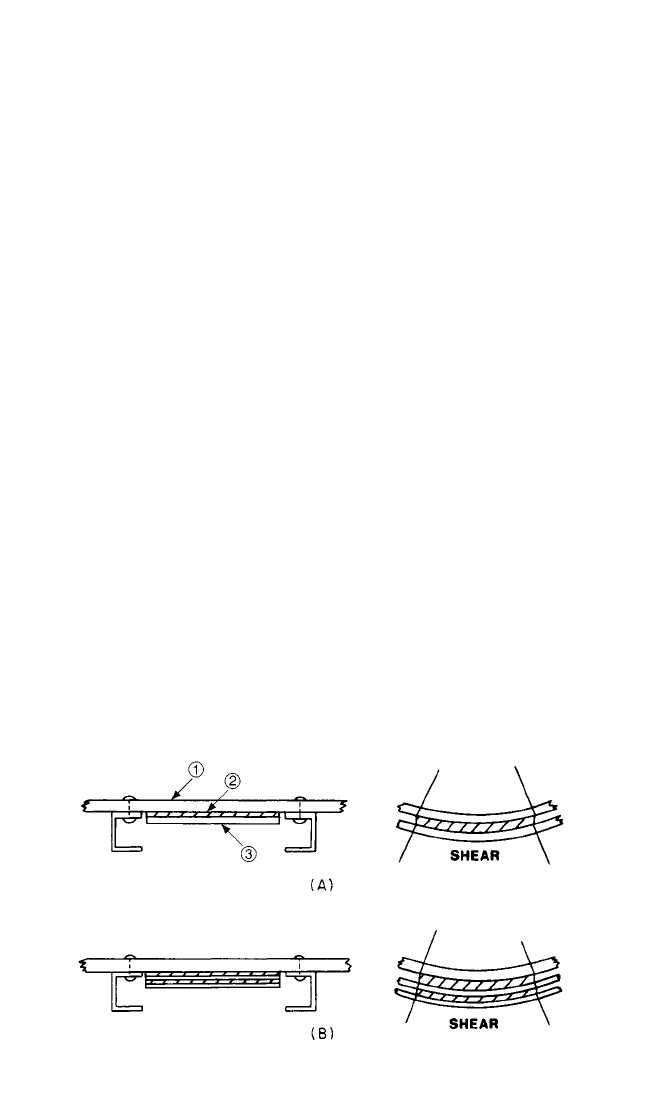
vibration to an acceptable level. Greater weight increases usually lead to diminish-
ing returns. This weight increase can be offset to some degree if the damping is
added early in the design, by judicious weight reductions achieved by proper sizing
of the structure to take advantage of the damping.
CONSTRAINED-LAYER DAMPING TREATMENTS
The mechanism of energy dissipation in a constrained-layer damping treatment is
quite different from the free-layer treatment, since the constraining layer helps
induce relatively large shear deformations in the viscoelastic layer during each cycle
of flexural deformation of the base structure, as illustrated in Fig. 37.4. The presence
of the constraining viscoelastic layer-pair changes the apparent flexural rigidity of the
base structure in a manner which depends on the dimensions of the three layers
involved and the elastic moduli of the three layers, as for the free-layer treatment, but
also in a manner which depends on the deformation pattern of the system, in contrast
to the free-layer treatment. A useful set of equations which may be used to predict
the flexural rigidity and modal damping of a beam or plate damped by a full-coverage
constrained-layer treatment are given in Ref. 1. These equations give the direct (in-
phase) component (EI )
D
of the flexural rigidity of the three-layer beam, and the
quadrature (out-of-phase) component (EI)
Q
as a function of the various physical
parameters of the system, including the thicknesses h
1
, h
2
, and h
3
, the moduli E
1
(1 +
jη
1
), E
2
(1 + jη
2
), E
3
(1 + jη
3
), and the shear modulus of the damping layer G
2
(1 + jη
2
).
Shear Parameter. The behavior of the damped system depends most strongly on
the shear parameter
g = (37.6)
which combines the effect of the damping layer modulus with the semiwavelength
(λ/2) of the mode of vibration, the modulus of the constraining layer, and the thick-
nesses of the damping and constraining layers. The other two parameters are the
thickness ratios h
2
/h
1
and h
3
/h
1
. Figure 37.5 illustrates the typical variation of η
n
/η
2
G
2
(λ/2)
2
E
3
h
3
h
2
π
2
37.8 CHAPTER THIRTY-SEVEN
FIGURE 37.4 Additive layered damping treatments. (A) Constrained-
layer treatment. (B) Multiple constrained-layer treatment.
8434_Harris_37_b.qxd 09/20/2001 12:26 PM Page 37.8
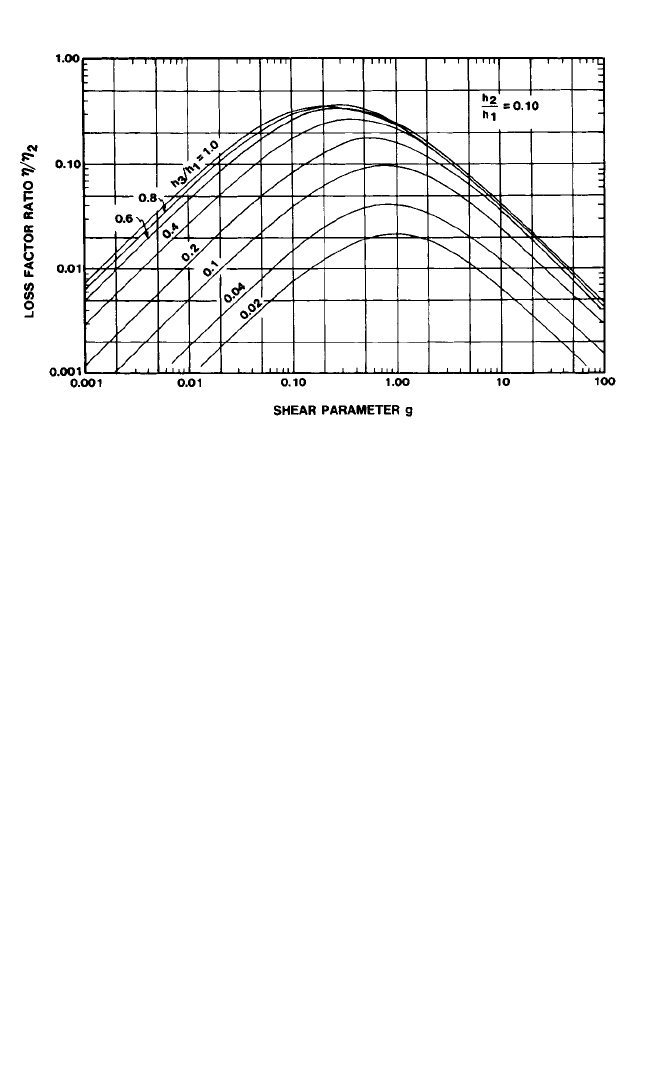
and (EI)
D
/E
1
I
1
with the shear parameter g for particular values of h
2
/h
1
and h
3
/h
1
.
These plots may be used for design of constrained layer treatments. Note that η
n
will
be small for both large and small values of g. For g approaching zero, G
2
or λ/2 may
be very small or E
3
, h
3
, and h
2
may be very large.This could mean that while G
2
might
appear at first sight to be sufficiently large, the dimensions h
2
and h
3
are nevertheless
too large to achieve the needed value of g. This could happen for very large struc-
tures, especially for high-order modes. On the other hand, for g approaching infinity,
G
2
or λ/2 may be large, or E
3
, h
2
, or h
3
may be very small.
Effects of Treatment Thickness. In general, increasing h
2
and h
3
will lead to
increased damping of a beam or plate with a constrained-layer treatment, but the
effect of the shear parameter will modify the specific values.The influence of h
3
/h
1
is
stronger than that of h
2
/h
1
, and as h
2
/h
1
approaches zero, η
n
/η
2
does not approach
zero but a finite value. This behavior seems to occur in practice and accounts for the
very thin damping layers, 0.002 in. (0.051 mm) or less, used in damping tapes.A prac-
tical limit of 0.001 in. (0.025 mm) is usually adopted to avoid handling problems.
Effect of Initial Damping. If the base beam is itself damped, with η
1
not equal to
zero, then the damping from the constrained-layer treatment will be added to η
1
for
small values of η
1
. The general effect is readily visualized, but specific behavior
depends on treatment dimensions and the value of the shear parameter.
Integral Damping Treatments. Some damping treatments are applied or added
not after a structure has been partly or fully assembled but during the manufactur-
ing process itself. Some examples are illustrated in Fig. 37.6. They include laminated
sheets which are used for construction assembly, or for deep drawing of structural
components in a manner similar to that for solid sheets, and also for faying surface
damping which is introduced into the joints during assembly of built-up, bolted, riv-
eted, or spot-welded structures. The conditions at the bolt, rivet, or weld areas criti-
cally influence the behavior of the damping configurations and make analysis
APPLIED DAMPING TREATMENTS 37.9
FIGURE 37.5 Typical plots of η/η
2
versus shear parameter g(h
2
/h
1
= 0.10, η
2
= 0.1).
8434_Harris_37_b.qxd 09/20/2001 12:26 PM Page 37.9
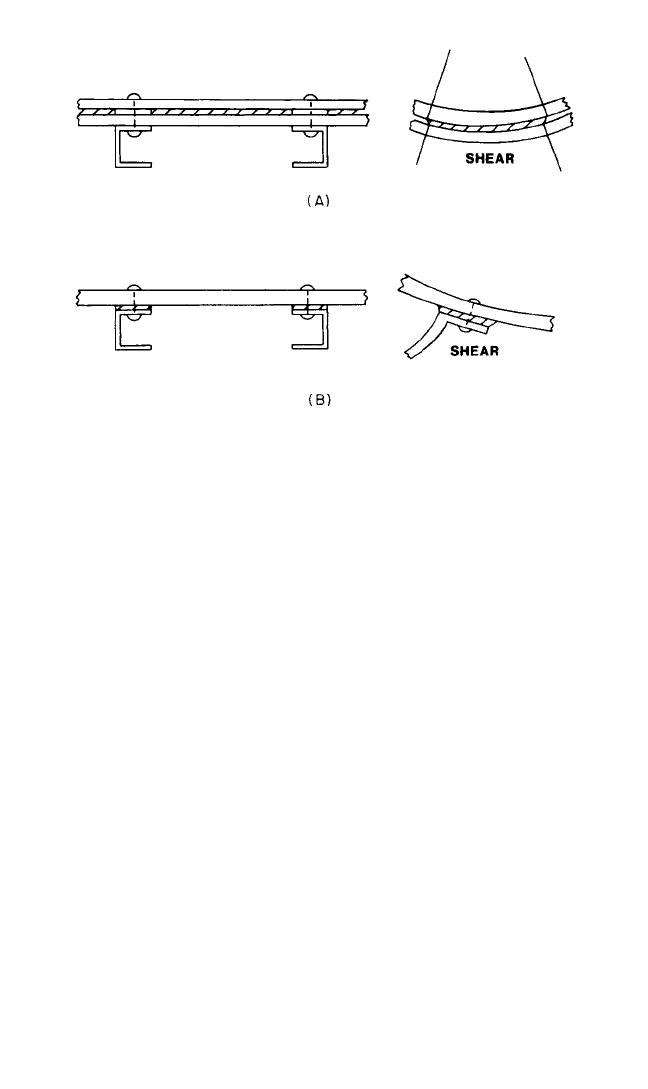
particularly difficult because of the limited control of conditions at these points.
Finite element analysis may be one of the few techniques for such analysis.
Damping Tapes. Constrained layer treatments are sometimes available in the
form of a premanufactured combination of an adhesive layer and a constraining
layer, which may be applied to the surface of a vibrating panel in one step, as
opposed to the several steps required when the adhesive and constraining layers are
applied separately. Such damping tapes are available from several companies,
including the 3M Company, Avery International, and Mystic Tapes, to name a few.
An example of such a damping tape is the 3M 2552 damping foil product, which
consists of a 0.005-in.-thick layer of a particular pressure-sensitive adhesive pre-
bonded to a 0.010-in.-thick aluminum constraining layer, with an easy-release paper
liner protecting the adhesive layer. One limitation of damping tapes is at once evi-
dent, namely, that the particular adhesive is effective over a specific temperature
range and the adhesive and constraining layer thicknesses are fixed. The choice of
adhesive is particularly important, since it must be selected in accordance with the
required temperature range of operation, and the available thicknesses may not be
ideal for all applications. Constrained layer treatments such as those illustrated in
Fig. 37.4 could be built up conventionally, with adhesive and constraining layers
applied separately, or by means of damping tapes. In each case, the adhesive mate-
rial and thickness, and the constraining layer thickness, must be chosen to ensure
optimal damping for the temperature range required by each application.The Ross-
Kerwin-Ungar (RKU) equations
1
may be used to estimate, even if roughly, the best
combination of dimensions and adhesive for each application, whether by means of
damping tapes or conventional treatments, applying the complex modulus proper-
ties of the adhesive as described by a temperature-frequency nomogram or by a
fractional derivative equation.
37.10 CHAPTER THIRTY-SEVEN
FIGURE 37.6 Some basic integral damping treatments. (A) Laminate. (B)
Faying surface damping.
8434_Harris_37_b.qxd 09/20/2001 12:27 PM Page 37.10

Tuned Dampers. The tuned damper is essentially a single degree-of-freedom
mass-spring system having its resonance frequency close to the selected resonance
frequency of the system to be damped, i.e., tuned. As the structure vibrates, the
damper elastomeric element vibrates with much greater amplitude than the struc-
ture at the point of attachment and dissipates significant amounts of energy per
cycle, thereby introducing large damping forces back to the structure which tend to
reduce the amplitude.The system also adds another degree of freedom, so two peaks
arise in place of the single original resonance. Proper tuning is required to ensure
that the two new peaks are both lower in amplitude than the original single peak.
The damper mass should be as large as practicable in order to maximize the damper
effectiveness, up to perhaps 5 or 10 percent of the weight of the structure at most,
and the damping capability of the resilient element should be as high as possible.The
weight increase needed to add significant damping in a single mode is usually
smaller than for a layered treatment, perhaps 5 percent or less.
Damping Links. The damping link is another type of discrete treatment, joining
two appropriately chosen parts of a structure. Damping effectiveness depends on
the existence of large relative motions between the ends of the link and on the exis-
tence of unequal stiffnesses or masses at each end. The deformation of the structure
when it is bent leads to deformation of the viscoelastic elements.These deformations
of the viscoelastic material lead to energy dissipation by the damper.
RATING OF DAMPING EFFECTIVENESS
MEASURES OR CRITERIA OF DAMPING
There are many measures of the damping of a system. Ideally, the various measures
of damping should be consistent with each other, being small when the damping is
low and large when the damping is high, and having a linear relationship with each
other.This is not always the case, and care must be taken, when evaluating the effects
of damping treatments, to ensure that the same measure is used for comparing
behavior before and after the damping treatment is added. The measures discussed
here include the loss factor η, the fraction of critical damping (damping ratio) ζ, the
logarithmic decrement ∆, the resonance or quality factor Q, and the specific damp-
ing energy D. Table 37.2 summarizes the relationship between these parameters, in
the ideal case of low damping in a single degree-of-freedom system. Some care must
be taken in applying these measures for high damping and/or for multiple degree-of-
freedom systems and especially to avoid using different measures to compare
treated and untreated systems.
Loss Factor. The loss factor η is a measure of damping which describes the rela-
tionship between the sinusoidal excitation of a system and the corresponding sinu-
soidal response. If the system is linear, the response to a sinusoidal excitation is also
sinusoidal and a loss factor is easily defined, but great care must be taken for non-
linear systems because the response is not sinusoidal and a unique loss factor cannot
be defined. Consider first an inertialess specimen of linear viscoelastic material
excited by a force F(t) = F
0
cos ωt, as illustrated in Fig. 37.7.The response x(t) = x
0
cos
(ωt −δ) is also harmonic at the frequency ω as for the excitation but with a phase lag
δ. The relationship between F(t) and x(t) can be expressed as
APPLIED DAMPING TREATMENTS 37.11
8434_Harris_37_b.qxd 09/20/2001 12:27 PM Page 37.11

F = kx + (37.7)
where k = F
0
/x
0
is a stiffness and η=tan δ is referred to as the loss factor. The phase
angle δ varies from 0° to 90° as the loss factor η varies from zero to infinity, so a one-
to-one correspondence exists between η and δ. Equation (37.7) is a simple relation-
ship between excitation and response which can be related to the stress-strain
relationship because normal stress σ=F/S and extensional strain ε=x/l. This is a
generalized form of the classical Hooke’s law which gives F = kx for a perfectly elas-
tic system.The loss factor, as a measure of damping, can be extended further to apply
to a system possessing inertial as well as stiffness and damping characteristics. Con-
sider, for example, the one degree-of-freedom linear viscoelastic system shown in
Fig. 37.8A. The equation of motion is obtained by balancing the stiffness and damp-
ing forces from Eq. (37.7) to the inertia force m(d
2
x/dt
2
):
m + kx +=F
0
cos ωt (37.8)
The steady-state harmonic response, after any start-up transients have died away,
is illustrated in Fig. 2.22. If k and η depend on frequency as is the case for real
materials, then the maximum amplitude at the resonance frequency ω
r
=
k
/m
is equal
to F
0
/k(ω
r
)η(ω
r
), while the static response, at ω=0, is equal to F
0
/k(0)
1 +η
2
(0)
.The
amplification factor A is approximately equal to 1/η(ω
r
), provided that η
2
(0) << 1.
Furthermore, the ratio ∆ω/ω
r
, where ∆ω is the separation of the frequencies for which
the response is 1/
2
times the peak response, is known as the half-power bandwidth
(see Fig. 2.22). It is also equal to η, provided that η
2
<< 1. In summary, therefore,
η= = (37.9)
∆ω
ω
r
1
A
dx
dt
kη
ω
d
2
x
dt
2
∂x
∂t
kη
|ω|
37.12 CHAPTER THIRTY-SEVEN
TABLE 37.2 Comparison of Damping Measures
Damping Loss Log Quality Spec Amp
Measure ratio factor dec factor damping factor
Damping ratio ζ
Loss factor 2ζη
Log decrement πζ 2πη ∆
Quality factor QA*
Spec damping 4πUζ 2πUη 4U∆ D
Amp factor QA*
* For single degree-of-freedom system only.
2πU
D
π
2∆
1
η
1
2ζ
2πU*
A
2πU
Q
2πU
D
π
2∆
1
η
1
2ζ
2π*
A
D
4U
π
2Q
1*
A
D
2πU
1
Q
2∆
π
1*
2A
D
4πU
1
2Q
∆
π
η
2
8434_Harris_37_b.qxd 09/20/2001 12:27 PM Page 37.12
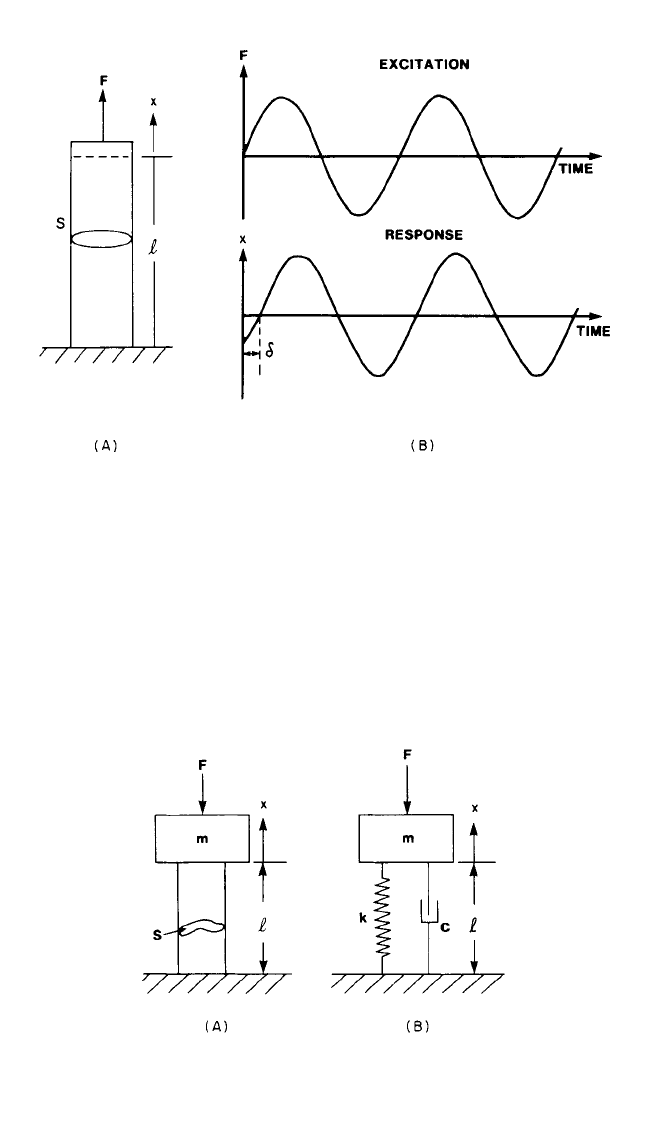
This relationship between η and 1/A is applicable only for a single degree-of-
freedom system and may not be directly applicable for more complex systems such
as beams, plates, or more complex structures. The measure ∆ω/ω
r
is applicable for
more complex systems, as well as single degree-of-freedom systems. For large values
of η, on the order of 0.2 or greater, none of these measures of damping agree exactly,
even for an ideal linear single degree-of-freedom system, but each measure is at
least self-consistent. The stiffness and loss-factor parameters defined here do not
specify any particular model of material behavior. For example, k and η could be
APPLIED DAMPING TREATMENTS 37.13
FIGURE 37.8 Single degree-of-freedom system with:
(A) viscoelastic damping; (B) viscous damping.
FIGURE 37.7 Linear viscoelastic behavior of a sample under sinusoidal loading,
described in terms of response and excitation as functions of time. (A) Specimen. (B)
Response and excitation.
8434_Harris_37_b.qxd 09/20/2001 12:27 PM Page 37.13

constants as for hysteretic damping, or they could be functions of frequency, tem-
perature, specimen composition and shape, or amplitude as for a nonlinear material.
The model with constant k and η is not too useful over a wide frequency range, and
such behavior is impossible over an infinite frequency range, but these parameters
can vary quite slowly with frequency for some particular material compositions. If k
and η vary strongly with frequency, or amplitude, then the various definitions of the
loss factor must be used with great care, since each measure gives different results.
Fraction of Critical Damping. The fraction of critical damping (damping ratio) is
a measure of one very specific mechanism of damping, i.e., viscous damping which is
proportional to velocity. If the damping forces acting on a single degree-of-freedom
mass-spring system, illustrated in Fig. 37.8B, satisfy this type of relationship, then the
equation of motion for harmonic excitation is
m + c + kx = F
0
cos ωt (37.10)
The response depends on m, k, and a parameter c/2
k
m
which involves c, k, and m
and is known as the fraction of critical damping (damping ratio). This parameter,
labeled ζ, controls the peak amplitude, the half-power bandwidth, and the resonance
frequency ω
r
:
x
max
= x(0) =
ω
r
=
(k
/m
)(
1
−
ζ
2
)
= 2ζ
(37.11)
The plot of x(ω) versus frequency ω, for specific values of m and k is very similar to
those for the viscoelastic damping, provided that η 2ζ. The distinction between
viscous and hysteretic damping (constant k, and η) is not at once apparent. Equa-
tions (37.8) and (37.10) convey the difference, since the damping coefficient in Eq.
(37.8) decreases in proportion to 1/ω as ω increases, while that in Eq. (37.10) is con-
stant with frequency, at least for the hypothetical cases considered here. Figure 37.9
shows plots of response versus frequency based on the solutions of these equations
of motion for each type of damping. Some differences arise at low frequency, but
they are not very great except for very high values of damping. For high values of
damping, neither η nor ζ are linearly related to the bandwidth ratio ∆ω/ω
r
. Figure
37.10 shows the variation of ∆ω/ω
r
with η and 2ζ for values of η which are not small.
Limits exist beyond which the ratio ∆ω/ω
r
does not give a good estimate of η or ζ.
Logarithmic Decrement. When a damped system is struck by an impulsive load
or is released from a displaced position relative to its equilibrium state, a decaying
oscillation usually takes place as illustrated in Fig. 2.8. A measure of damping called
logarithmic decrement ∆ is defined as the natural logarithm of the ratio of ampli-
tudes of successive peaks [see Eq. (2.19)]:
∆=ln = ln (37.12)
This definition is useful only if these ratios are equal for the various cycles, i.e., for
specific types and amounts of damping. The measure is useful for viscous and hys-
x
n
x
n + 1
x
1
x
2
∆ω
ω
r
F
0
k
F
0
2kζ
1
−
ζ
2
dx
dt
d
2
x
dt
2
37.14 CHAPTER THIRTY-SEVEN
8434_Harris_37_b.qxd 09/20/2001 12:27 PM Page 37.14
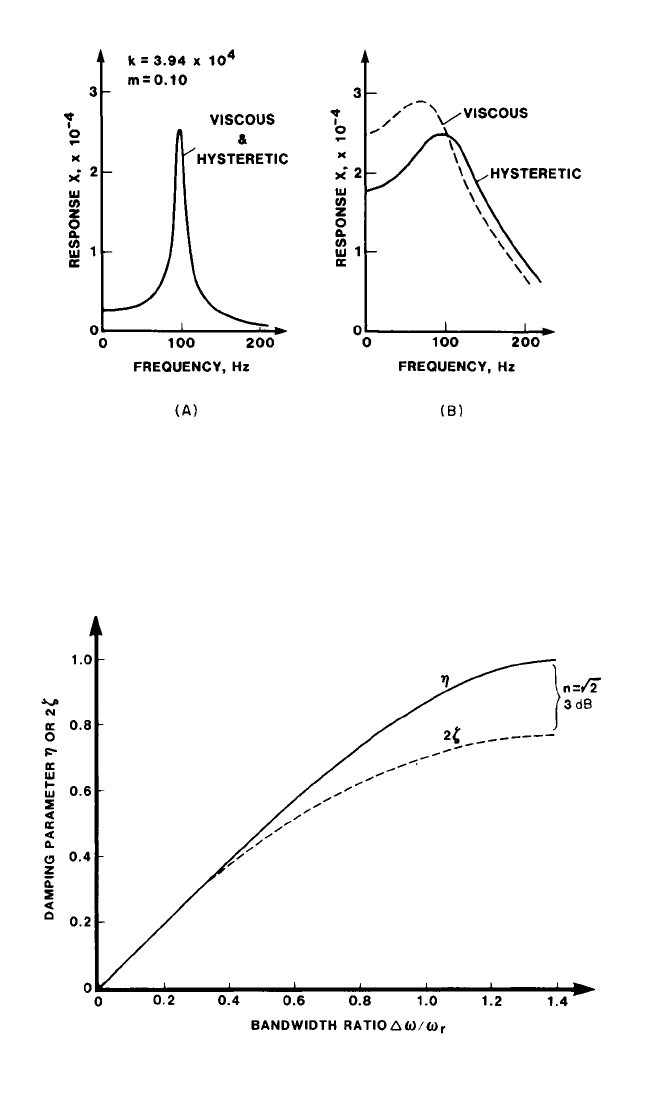
APPLIED DAMPING TREATMENTS 37.15
FIGURE 37.10 Variation of loss factor (η) and 2 times the fraction of critical damping
(2ζ) of a single degree-of-freedom system with ∆ω/ω
r
.
FIGURE 37.9 Comparison of viscous and hysteretic damping of a single
degree-of-freedom system with (A) low damping (η=0.1, ζ=0.05); (B) high
damping (η=1.0, ζ=0.5).
8434_Harris_37_b.qxd 09/20/2001 12:27 PM Page 37.15

37.16 CHAPTER THIRTY-SEVEN
teretic damping, within limits. For viscous damping, the solution of Eq. (37.10) for an
impulsive excitation F δ(t) is obtained.
x = e
−t
k/
m
sin t
(k
/m
)(
1
−
ζ
2
)
(37.13)
so that
∆= (37.14)
for small ζ. If ζ approaches 1.0, the response becomes aperiodic and a logarithmic
decrement cannot be defined or related to ζ. The loss factor in Eq. (37.7) also can
be related to the transient response of a single degree-of-freedom mass-spring sys-
tem, subject to an impulsive excitation. Consider the impulsive excitation F(t) to be
modeled as a spike of the form of a delta function at time t = 0. Then the equation
of motion, in the form of Eq. (37.8), cannot be written directly, but if F(t) and x(t)
are both described in terms of their corresponding Fourier transforms, then
¯
F(ω) =
∞
−∞
F(t) exp(−jωt) dt = F and ¯x = F/(k − mω
2
+ jkη). The inverse Fourier transform
gives
x(t) =
∞
−∞
(37.15)
This equation contains real and imaginary parts, but using the fact that exp(jωt) = cos
ωt + j sin ωt and if k(ω) = k(−ω) and η(−ω) =−η(ω), then it may be shown that x(t) is
given by
x(t) =
∞
0
dω (37.16)
For k and η constant over all frequencies from zero to infinity, problems arise
regarding x(t) being finite for values of t less than zero, i.e., before the impulse is
applied, and this is physically impossible. The problem is that k and η cannot be con-
stants for real systems over any extremely wide frequency range, no matter how
close to constant they may be over a limited frequency range. For small values of η,
however, a useful and accurate solution is given by
x(t) = e
−1/2ηt
k/
m
sin t
k
/m
(37.17)
∆=πη/2 (37.18)
Comparing Eqs. (37.14) and (37.18) gives
η=2ζ (37.19)
Quality Factor. The quality factor Q is defined as ω
r
/∆ω,so
Q = (37.20)
For a single degree-of-freedom Q = A [where A is defined in Eq. (37.9)], but this is
not the case for multiple degree-of-freedom systems.
1
η
F
k
m
(k − mω
2
) cos ωt + kη sin ωt
(k − mω
2
)
2
+ (kη)
2
F
π
Fe
jω t
dω
k − mω
2
+ jkη
1
2π
πζ
1
−
ζ
2
F
k
m
(1
−
ζ
2
)
8434_Harris_37_b.qxd 09/20/2001 12:27 PM Page 37.16
